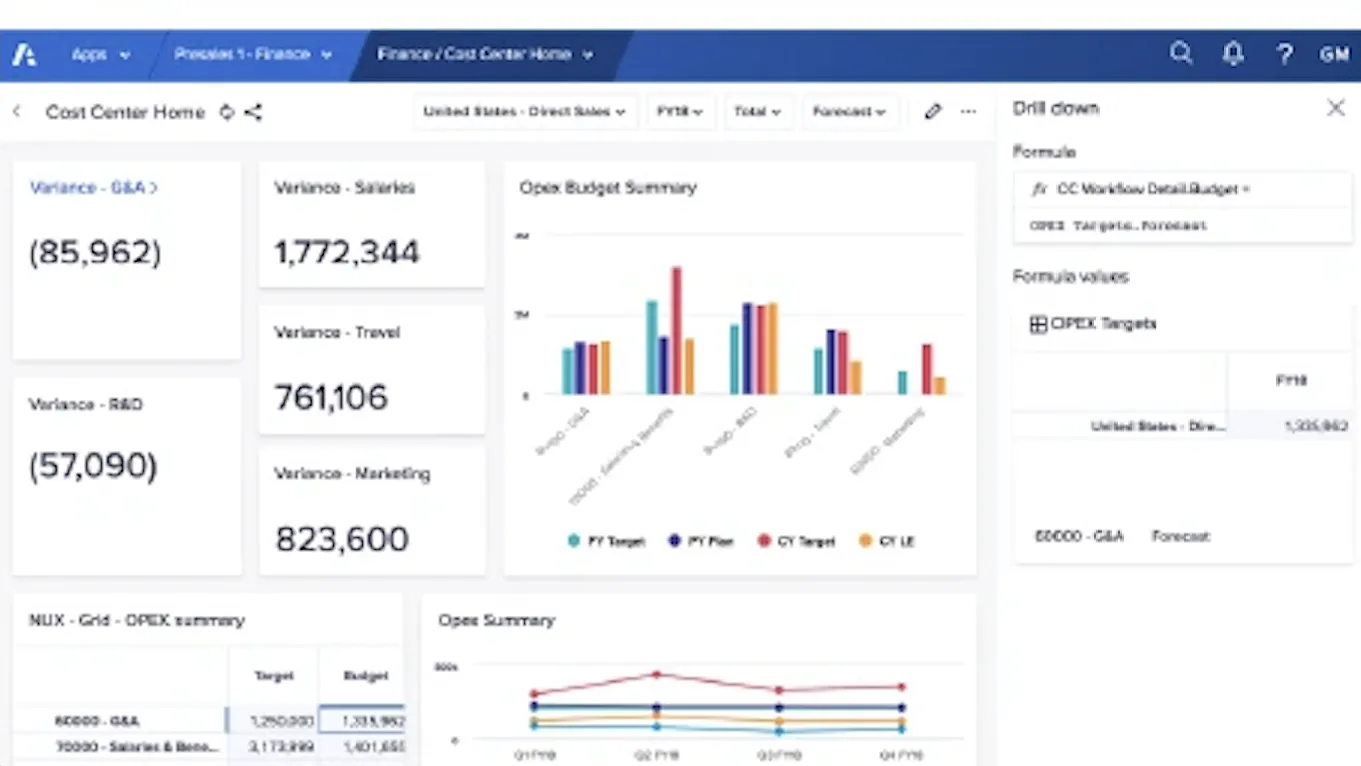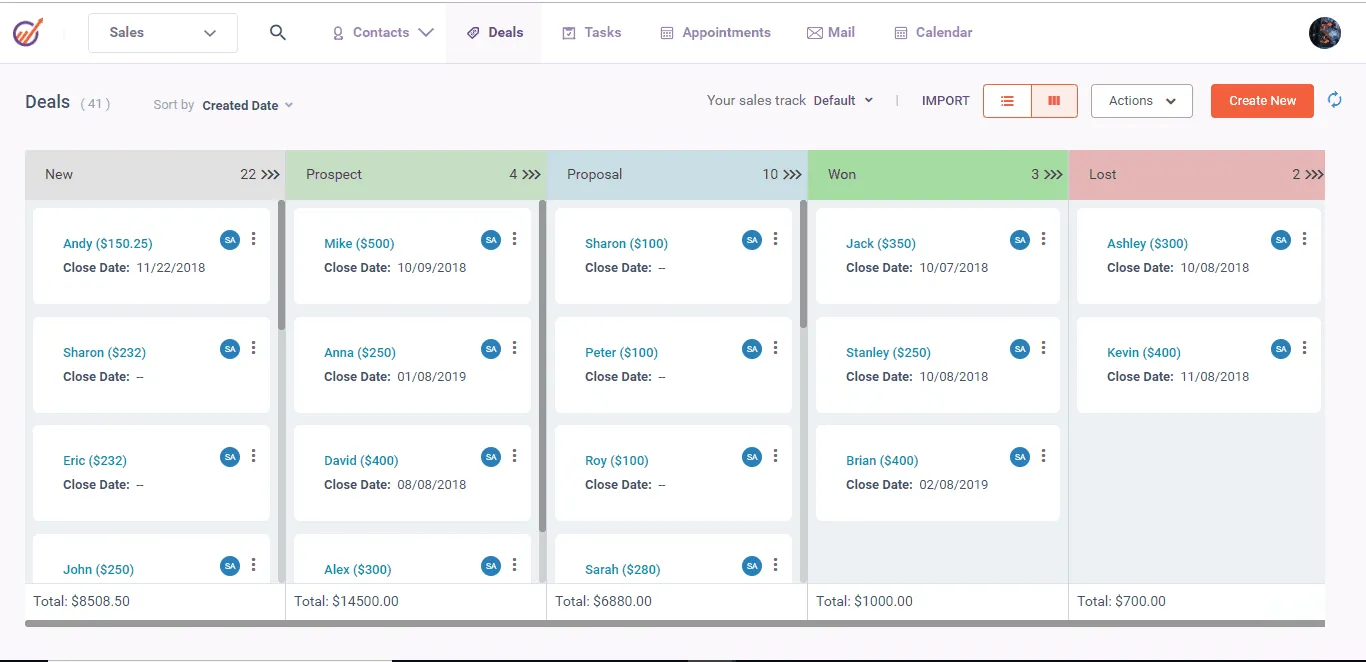Wouldn't it be great if you could look into a crystal ball and find out just how much revenue your company will generate in the next quarter? Or fiscal year? Or in the next 3-5 years?

It turns out you can do that through sales projections. However, projecting sales is riddled with uncertainty because you‘re trying to estimate revenue generated from leads that you haven’t yet captured. So, how do you create an accurate sales projection for your company?
That’s why this guide exists. By the end, you’d have learned what a sales projection is, how it benefits your business, how to create accurate sales projections, and some tools you can use to ease the sales projection process.
Table of Contents
- What is a sales projection?
- What are the benefits of sales projection?
- How to Create a Sales Projection
- Sales Projection Tools
- Tips for Making Sales Projections
What is a sales projection?
A sales projection estimates future sales revenue over a particular period. It’s made by analyzing historical sales data, identifying patterns and trends, and using that to predict the revenue they’ll generate in the near future.
The sales team also considers the following when creating a sales projection:
- The economic factors that might affect the business.
- The current state of the market and the position the business occupies within it.
- Your budget for customer acquisition.
If you’re launching a new product or feature, the sales team will try to project sales for three scenarios: the best-case scenario, the worst-case scenario, and the most likely scenario — which is usually the middle ground between the first two.
Sales projections are critical because they allow companies to set realistic sales goals, track their progress over time, and estimate future revenue. Without accurate sales projections, companies will find it hard to set SMART sales goals or make data-driven decisions on allocating resources.
When this happens, companies usually teeter between underperforming and overperforming against their targets. This is a disorienting place to be because of the uncertainty that comes with not knowing whether you’ll hit your set targets or not.
The accounting department also uses sales projections to determine the budgets for different aspects of the business, estimate financial outcomes, assess financial risk, and conduct overall business planning.
What are the benefits of sales projections?
Projecting sales (and revenue) helps business leaders make informed decisions about business operations and track their progress toward long-term goals and objectives. Below are several reasons why sales projections are important.
1. Make better decisions.
Sales projections provide important data that helps business leaders make informed decisions about product pricing, finances, staffing needs, marketing strategy, and sales processes. Business teams usually have more confidence in these decisions because they’re not made on a whim.
2. Set SMART goals.
Sales representatives are usually ambitious people who try to exceed their quotas. However, asking them to close more deals than is realistically possible will cause them to lose their enthusiasm and love for their jobs — which translates into unmet quotas and reduced revenue.
Predicting sales, however, can help you set attainable goals based on hard data. And because these goals/targets are realistic, your sales team will be hyped to hit (or even exceed) them.
3. Set clear budgets.
Accurate sales projections show patterns in economic growth potential and revenue. This allows you to balance cost and revenue and allocate your resources to the right teams and channels.
You’ll also be able to predict the capital you have available to make investments that encourage business growth, such as new software or training for teams.
4. Manage inventory better.
If you’re selling physical products, a sales projection will help you decide how much inventory you need and which products to stock. This way, the goods you have available will meet the exact needs of your customers.
Your customers won’t complain that they didn’t find what they needed at your store, and no product will go to waste as a result of not being sold.
5. Fulfill staffing needs.
An accurate sales projection helps you determine how many salespeople you need to handle the predicted deals. If your projection requires you to have more people on the team, you’ll be able to hire, onboard, and train them to handle all the deals.
The projection will also help you identify seasonal trends and other changes in the industry, so you can hire freelancers or temporary staff when you need to.
6. Offer quality customer service.
When you have an idea of how many deals you’ll get in a specific period, you’ll be able to prepare your customer support team to efficiently handle calls, emails, or chats coming through from prospects and customers.
7. Evaluate sales performance.
A sales projection requires you to track your progress over time. So if you estimate that you’ll close $1 million worth of deals in the first half of the year and you end up bringing in $700K, you’ll know that something is wrong. Your sales projection formula could be incorrect, or there could be some other issue that caused your team to fall short of the target.
Either way, you’ll be able to investigate further. You may find out that someone on your team isn’t pulling their weight, or you may discover new ways to improve your sales process. Whatever the case, you’ll solve the problem quickly and get back on track.
How to Create a Sales Projection
To create an accurate sales projection, here are six steps you should follow.
1. Identify potential sales opportunities.
The first step to creating a sales projection is identifying potential sales opportunities. To do that, consider these four things:
- Products. Specify the kinds of products you’re selling (or have sold). Do these products satisfy your prospects’ needs? How will selling these products contribute to the business’ sales goals?
- Services and solutions. If your company offers services and/or solutions alongside products, consider the additional revenue you’ll potentially generate from those as well.
- One-time payments. If people only need to pay for your product once, you need to consider the number of units you’ll need to sell to meet your sales goals.
- Subscriptions. If you use the subscription business model, factor in monthly and annual subscription renewals into your quantitative data for making your sales projection.
Note: An organization can use one-time and subscription-based payments as part of their sales strategy.
2. Review historical data.
The best way to ensure that your sales projections are accurate is to thoroughly analyze data from previous years, including the number of leads you got, how many you converted, and how many you lost. This data can give you a better understanding of sales trends, market conditions, and effective sales techniques — all of which will determine your projections for the future.
Matthew Ramirez, the owner of Rephrasely, understands how historical data can be a reliable basis for more precise projections.
“If one is aware that 10% of the visitors to their website make a purchase, they can employ this information to form an estimation regarding the volume of sales they will generate from a particular number of website visitors,” Ramirez says.
“By establishing a correlation between the current data pertaining to the sales funnel and future sales objectives, one can derive a more precise understanding of the performance of their sales.”
Note: Sales professionals typically use customer relationship management (CRM) tools and/or dedicated sales management software to track sales opportunities, customer contact details, history, and outcomes.
3. Examine market factors and seasonality.
After reviewing historical data, analyze your market environment to determine potential growth areas within your industry. Note any obstacles that can hinder you from achieving your sales goals for the projected period (i.e., next quarter or next year).
Try to estimate possible changes in customer behavior due to external factors, such as economic conditions and political climate.
Consider both short-term fluctuations due to seasonality (e.g., holidays and periods of demand spikes) as well as long-term shifts. These trends can result from technological advancement or other disruptive forces that impact traditional buying patterns.
4. Gather information from your sales team.
Next, gather qualitative data about the individual contributions of your sales team and their sales process. Ask your team about the following.
Quotas
Ask each team member about their current sales quotas, i.e., the minimum amount of sales/revenue that a salesperson must generate in a month, quarter, or year. Knowing your team members’ sales expectations can help you set realistic sales expectations for them.
Pricing
Knowing the value of the products and/or services being sold helps you make accurate projections because you’ll be able to multiply the pricing of a deal by the projected number of closed sales opportunities.
Sales Cycle
A sales cycle is the amount of time it takes to complete a sale. It starts with the initial contact of a prospect and ends with a payment. Different products and services have varying sales cycles, so understanding the cycles for each of your offerings will help you get accurate numbers.
5. Identify sales goals.
Sales goals are measurable objectives that guide sales teams through their day-to-day sales activities and help them make strategic business decisions. These goals are usually based on sales KPIs and metrics, such as win rate, year-over-year (YoY) growth, and total revenue.
Setting realistic sales goals is crucial to making accurate sales projections. Here are three things to consider when setting sales goals for your company.
Your Sales Team’s Capacity
If your sales team has enough members to operate in different geographic locations, you can set large goals for them. But if you have a small, locally-focused team, set less ambitious goals that they can achieve without overworking themselves.
The Composition of Your Products/Services
Determining if your products are “low cost–high volume” or “low volume–high cost” can help you create realistic sales goals. For instance, if your products are low cost–high volume, you’ll focus on the number of sales made. But if you have a high-cost/low-volume business, you’ll focus more on the total value of sales (in dollars).
Sales Initiatives
If your team has any sales or marketing initiatives, factor that into the goals you set. These initiatives to boost sales may include expanding into new markets or launching new products.
6. Make assumptions and adjust as needed.
By now, you must have all the data you need — both quantitative and qualitative — to make accurate sales projections. Bear in mind that projecting sales and revenue is a process that is fraught with uncertainty.
Instead of brooding over details, make assumptions quickly and adjust as you analyze the data, just like Dan Thomas does at AIQuoter.
“First, we pick a fictional number to represent our projected future sales and then reverse engineer what’s needed (resources and conditions) to achieve it,” says Thomas. “We do the calculations to help us review the realisticness of our chosen number and then adjust the fictional number and/or other contributing factors for a realistic roadmap.
“Using elements like graphs, infographics, matrices, and charts, we can visualize the projections, identify patterns and trends, and communicate the data to stakeholders to help them make more informed decisions.”
Sales Projection Tools
Sales projection tools are that crystal ball that shows how much revenue your company will generate in the near future. These tools accurately predict future sales performance by analyzing your lead volume, pipeline value, and the probability at which you close deals.
Sales projection software answers three questions:
- How much revenue do we expect to generate in the future?
- What type of leads have the greatest impact on our predictions?
- How do our past sales compare to predicted revenue?
Once these questions are answered, you’ll know which prospects to pursue, which sales activities to focus on, whether to adjust your sales team’s quota(s), and how to boost sales for your company.
Want to know the sales projection tools that can give you accurate sales revenue predictions? Here are five of them.
1. HubSpot’s Sales Forecasting Tool.webp)
Get started with HubSpot’s Sales Forecasting Tool
HubSpot’s sales forecasting tool is a platform that gives you a comprehensive overview of your entire sales pipeline, so you can make the right decisions for your business. With this tool, you can see how your business has been performing over a specific period and inspect deals to ensure that your sales team is converting the leads that have the most impact on your bottom line.
This tool is powerful, easy to use, and customizable. In fact, it has customizable forecast categories that allow you to modify the tool to match your business needs.
What we like: HubSpot’s sales forecasting tool is part of a powerful CRM that gathers sales analytics it can use to correctly predict sales revenue. So if you use HubSpot as your sales CRM, you can directly pull data that will enable you to build accurate forecasts.
Key Features
- This tool can automatically roll up custom forecasts submitted by sales reps and managers to give business leaders a bird’s-eye view of where their teams will land.
- The forecasts from this tool give managers the ability to drill down into the performance of individual sales pipelines and lead their teams to success.
- This tool pulls data straight from the CRM so that sales teams can see multiple pipelines. This way, both sales and service teams can create pipelines and forecasts.
- This tool gives you in-depth insights into your team’s performance with forecast categories, historical snapshots, weighted sales pipelines, and performance metrics.
Pricing: HubSpot’s sales forecasting tool is available in premium editions of Sales Hub and Service Hub. These Hubs are available at two price points: $450 per month for a professional plan and $1,200 per month for enterprise, billed annually.
2. Anaplan

Anaplan is a connected planning platform that caters to large enterprises by offering solutions for finance, operating planning, supply planning, sales and marketing, and HR & workforce.
Anaplan has a sales forecasting tool that allows sales teams to integrate and analyze data to make informed decisions. With Anaplan, sales managers can make forecasts by account, product line, or territory. There’s a “Predictive Insights” feature that helps sales managers identify promising opportunities so they can allocate the right resources to each one.
What we like: Although Anaplan is not a CRM, it does focus on helping the finance, sales, marketing, HR, and operations teams work together to increase revenue. This allows for an adequate flow of data and the elimination of data silos that can stunt business growth.
Key Features
- This tool provides accurate sales forecasts to company leaders, which enables business departments (including finance, sales, marketing, and HR) to make better decisions.
- This tool gives teams a clear view of their sales and revenue, enabling them to analyze these pipelines across different dimensions.
- This tool allows teams to generate sales forecast benchmarks from their historical sales performance and third-party data.
Pricing: Anaplan has three pricing tiers: Basic, Professional, and Enterprise. However, it offers custom pricing depending on which tier you choose.
3. Keap

Keap is an all-in-one sales and marketing automation tool that helps small businesses collect and convert leads with its automation, forecasting, and management features.
What we like: Although Keap is a CRM designed mainly for small businesses, it offers seamless integration with many existing sales and marketing software, including BigCommerce, Gmail, Leadpages, WordPress, and Zapier. This creates a smooth marketing and sales loop that makes it easier for sales teams to reach out to and nurture new leads.
Key Features
- This tool allows users to create multiple, customizable pipelines that sync with Keap’s CRM to convert leads into paying customers.
- Keap’s automation feature takes care of capturing new leads, sending emails and follow-ups, and moving leads through your sales funnel.
- This tool offers analytics that shows you the performance of your sales pipeline. You’ll get access to various reports, including average deal duration, deal conversions by stage, and deal revenue forecasting.
Pricing: Pro plans cost $149 monthly for two users and 1,500 contacts, billed annually. Max plans cost $199 monthly for three users and 2,500 contacts, billed annually.
4. Pipedrive
Pipedrive is a sales-focused CRM and pipeline management platform that allows teams of all sizes to set up pipelines, track their progress, and automate growth.
This tool is highly visual and customizable by design, which enables salespeople to see their entire sales process at a glance and customize it to match their sales cycle. Sales managers can use the data Pipedrive collects from their pipeline to project sales volume and revenue.
What we like: Most CRMs cater to different business departments, including marketing, sales, and customer service. Pipedrive prioritizes the sales department and has features that specifically help salespeople meet (and exceed) their quotas.
Key Features
- Pipedrive automates processes like lead scoring and lead engagement, which frees up time for salespeople to work on tasks that matter.
- This tool has deal management features like a custom chatbot, web forms, and real-time pipeline updates that help sales teams generate more leads.
- Pipedrive allows users to categorize, filter, segment, and sort leads to create custom lists they can target with personalized communications.
- Pipedrive provides comprehensive, but easy-to-understand, sales reports that help salespeople understand the state of their pipelines.
Pricing: Pipedrive offers four pricing tiers, billed annually. Essential plans cost $9.90 monthly. Advanced plans cost $19.90 monthly. Professional plans cost $39.90 monthly. Enterprise plans cost $59.90 monthly.
5. EngageBay

EngageBay is an all-in-one CRM platform designed to help marketing, sales, and customer support teams acquire, nurture, and convert leads. With EngageBay, users can record and analyze their sales and marketing data to make accurate projections and adjustments.
What we like: EngageBay is an integrated solution that has everything customer-facing business departments need to guide prospects through their buyer journey.
There are powerful marketing tools, including email marketing, marketing automation, lead generation, and social suite tools. There’s also a free CRM that helps users store customer information and a slew of sales tools that allow users to create multiple deal pipelines, automate sales processes, and send email sequences.
Finally, there are service tools such as Help Desk, Feedback Forms, and Knowledge Base that allow the customer support team to offer better service to customers and prospects alike.
Key Features
- EngageBay allows you to run as many deal pipelines as you need to. You can use the preset filters to categorize active pipelines.
- With EngageBay, you can track and get insights into what your customers do and how they behave on your website.
- If your sales team failed to meet their quotas due to a lack of enthusiasm, EngageBay’s sales gamification feature allows you to create a friendly competition among your sales reps to encourage them to put in their best.
Pricing: EngageBay has a free version. Basic plans cost $13.79 per user a month. Growth plans cost $45.99 per user monthly. Pro plans cost $91.99 per user monthly.
Tips for Making Sales Projections
While the process of creating a sales projection is pretty simple, it can be difficult to get accurate numbers. Here are some tips for making sure your sales projections are accurate and trustworthy.
1. Know your sales figures.
A sales projection should be rooted in actual data. Before making a projection, calculate your past and current sales figures.
Figure out how much revenue your business has generated in the past couple of months. Then, analyze your current sales pipeline, including prospects, leads, and closed deals. Calculate your win rates and conversion rates, and use these figures to project the number of deals you’ll likely close in the near future.
Knowing your sales figures will help you make a realistic projection that sales reps will be able to deliver at the end of the projection period.
2. Study industry trends and benchmarks.
Paying attention to industry trends can help you anticipate changes in customer behavior.
Brandon Kent, the vice president of Telemark Diversified Graphics advises that salespeople should “research industry benchmarks and compare your projections against similar businesses or competitors. This helps validate your assumptions and provides a benchmark for performance.”
Kent is right. Companies like Forrester and Gartner keep a close eye on industry trends and compile them into reports that can come in handy when you’re making sales projections.
3. Collaborate with various business departments.
To get more accurate projections, you should involve team members from different departments, including finance, marketing, operations, and product. This helps you gather diverse insights and perspectives into how their initiatives may impact future sales.
For example, if the marketing team is rolling out a brand new campaign, you’ll likely get more leads from that, so you should factor it into your sales projections.
4. Use customer data.
Customer data is an important part of sales projections because it can help you understand the customer groups that are most likely to purchase your product(s) — and the kinds of products they go for. For example, if you sell products that are popular with busy moms, you might want to focus your sales projections on this demographic.
Alister Wood, the owner at VisitUs, knows the critical role customer data plays in sales projections. “Examine factors such as the total number of customers, average order size, frequency of order, and any seasonal trends that may have affected the prior year’s revenue numbers,” he says.
“Having this information will help you accurately assess where future revenues will likely come from based on existing sources, rather than relying solely on speculation about future prospects and business opportunities.”
5. Stay flexible.
It’s easy to feel as though your sales projections are set in stone and should be the benchmark that every business department aspires to. But this shouldn’t be the case. Your sales projection should be a flexible number that gives you an idea of how much revenue you’ll generate so you can prepare adequately for it.
“You don’t want to get so wrapped up in your projections that they become an inflexible goal that drives everything else in your company’s strategy or product development efforts — or worse, makes them seem unattainable when they aren't actually impossible after all (just very difficult),” says Gauri Manglik, the CEO and co-founder of Instrumentl.
“Keep an open mind about what might happen next year and adjust accordingly so you don‘t end up feeling like a failure when things don’t go according to plan.”
6. Use a sales forecasting tool.
A sales forecasting tool can make it much easier and quicker to come up with accurate sales projections. According to Gauri Manglik, using a forecasting tool can “tell you exactly how many leads turned into actual customers in previous years, at similar times of the year, and in similar markets as yours.”
These analytics ensure that you make projections that are based on data, rather than wishful thinking.
Make Better Sales Projections for Your Business
Sales projections are important for determining how much money you‘ll make and for setting clear goals for your sales team. That’s why you should ensure that your sales projections are accurate.
Accurate numbers motivate your sales team to meet (and eclipse) their targets — which is a great mark of success for your business.






![12 Tactics for Better Sales Forecasting [+5 Forecasting Models to Leverage]](https://blog.hubspot.com/hubfs/sales-forecasting-model_2.webp)




